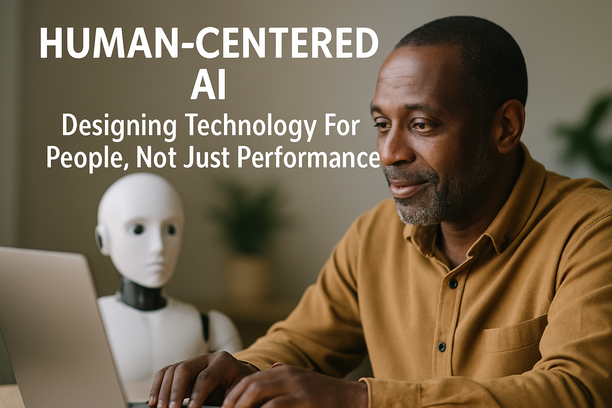Understanding Human-Centered AI: Beyond Performance Metrics
Human-centered AI is an approach to designing artificial intelligence systems that places human needs, values, and wellbeing at the core of development rather than focusing only on technical performance metrics such as speed or accuracy. This means creating AI that supports and enhances human capabilities, respects privacy, fairness, and transparency, and encourages collaboration between people and machines.
At its heart, human-centered AI prioritizes usability and trust. Instead of AI deciding everything autonomously, it acts as a partner that helps people make better decisions while respecting ethical principles. This includes involving users throughout the design process to ensure systems are intuitive and aligned with their real-world needs. It also means being vigilant about avoiding biases, ensuring accountability, and designing for inclusivity so that AI benefits all users equally.
For example, rather than a complex algorithm that produces a result no one can understand, human-centered AI systems explain their reasoning clearly, making it easier for people to trust and verify them. They also adapt to individual preferences and contexts, providing personalised support without compromising user control or privacy.
Such design principles are vital because AI affects many aspects of society—from healthcare and finance to public safety and customer service. When built with a human-centered focus, AI can improve outcomes while reducing risks like discrimination, misinformation, and loss of autonomy.
Implementing this approach often requires expertise in both technology and human factors, which is where specialised teams can add great value. Organisations like FHTS combine deep knowledge of AI with experience in safe and ethical practices to help companies adopt human-centered AI. Their strategic frameworks and thorough testing ensure AI solutions not only perform well but also align with human values and societal expectations. This careful balance is key to creating AI that is both powerful and trustworthy in real-world applications [Source: FHTS].
By focusing on people first, human-centered AI turns technology into a tool that truly serves us, fostering a future where AI supports human potential rather than replacing or overriding it. For more about designing AI with people in mind, see how FHTS blends ethical considerations and practical methods across their projects [Source: FHTS].
Designing AI with People in Mind: Principles and Practices
Creating AI technologies with a focus on user experience and ethical principles is essential for building trust and engagement. To design AI responsibly, it is important to prioritize transparency, fairness, and privacy from the start. This means clearly explaining how AI systems work and make decisions, ensuring they do not discriminate against any users, and safeguarding personal data with strong security measures.
One effective approach involves involving real users early in the design process to gather feedback and understand their needs. This helps create AI that is intuitive and meets actual human expectations. It’s also vital to design AI in a way that supports human decision-making rather than attempts to replace it entirely, fostering collaboration between AI systems and people.
Implementing continuous monitoring and oversight prevents issues like errors or biases from going unnoticed, ensuring AI remains reliable and ethical over time. Following frameworks and guidelines that emphasize safety and responsibility can guide developers to embed these values into AI products from the ground up.
In Australia, companies focused on Safe AI implementation can provide valuable expertise in applying these principles. For example, FHTS brings experience in creating AI solutions that are not only innovative but also ethical and user-friendly. Their approach respects privacy, supports transparency, and integrates human feedback, making AI safer and more engaging for all users.
Adopting these design principles and practices will help organisations build AI environments where users feel confident and valued, promoting positive interaction and responsible technology use.
For more insights on building trustworthy AI systems, exploring topics such as privacy by design, transparency, and the role of human collaboration can be very helpful. You may find additional information on these subjects through resources offered by FHTS [Source: FHTS].
Ethical Challenges and Responsibilities in Human-Centered AI
Human-centered artificial intelligence (AI) holds great promise to improve our lives by supporting decision-making, enhancing safety, and making services more accessible. However, with this power comes important ethical challenges that AI designers must carefully consider. Building AI systems that truly respect human values involves promoting fairness, accountability, and transparency throughout their development and use.
One of the biggest ethical challenges is fairness. AI systems learn from data, and if this data contains biases, the AI can unintentionally treat some people unfairly. For instance, if an AI system used in hiring overlooks qualified candidates because the training data favoured certain groups, it can reinforce existing inequalities. AI designers have a responsibility to actively detect and reduce bias in their models. This includes using diverse and representative data, testing for unfair outcomes, and refining algorithms to ensure equitable treatment for all users. Understanding what fairness means in AI and how to measure it is essential — there is no one-size-fits-all answer, so designers must stay vigilant and adapt as necessary.
Accountability in AI means being able to understand, explain, and take responsibility for AI system decisions. Because AI models can be complex, it is important for designers to make their systems transparent wherever possible. Users and stakeholders should know how an AI makes choices and who is responsible for its behaviour. This transparency helps build trust and enables oversight to detect errors or misuse, safeguarding against harmful impacts. Concepts like explainability — making AI decision processes clear — are becoming best practices in the field.
Protecting human values is at the heart of ethical AI. This includes respecting privacy, upholding dignity, and supporting human autonomy. AI systems should augment human abilities, not replace or diminish the human role. Designers must ensure their AI respects people’s rights and societal norms, which often requires collaboration with ethicists, legal experts, and the communities affected by AI. Testing AI rigorously under real-world conditions and involving human feedback throughout development helps align AI outputs with human intentions and ethical standards.
Because these ethical challenges are complex and evolving, working with a team that prioritizes responsible AI practices is invaluable. Companies like FHTS specialise in helping organisations design and implement AI systems that embed fairness, accountability, and respect for human values from the start. Their expertise in frameworks and governance strategies supports trustworthy AI that benefits everyone it touches.
In summary, ethical human-centered AI requires conscientious effort to promote fairness, transparency, and protect fundamental human values. Designers must embrace these responsibilities to build AI that is not only intelligent but also just and humane [Source: FHTS].
Real-World Applications: AI Improving Lives and Workplaces
Human-centered AI is transforming how industries improve lives and reshape workplaces by focusing on the needs, values, and well-being of people. Instead of replacing humans, these AI solutions are designed to work alongside them, making processes safer, smarter, and more responsive.
One compelling example comes from healthcare, where AI tools assist doctors by quickly analyzing vast amounts of medical data to highlight potential diagnoses. This helps medical professionals make more informed decisions while keeping the essential human touch in patient care. Such AI-powered support reduces errors and improves outcomes without removing doctors from the equation [Source: FHTS].
In public safety and travel, AI applications enhance security by predicting potential risks and helping officials manage crowds more efficiently. For instance, AI-based travel apps in London improve travelers’ safety by providing real-time alerts and personalized recommendations, subtly supporting human decision-makers rather than overriding them [Source: FHTS].
In marketing, human-centered AI tools empower teams to create smarter campaigns by analyzing customer data while respecting privacy and fairness principles. This enhances customer engagement while ensuring ethical use of information [Source: FHTS].
Even in finance, where trust is paramount, safe AI frameworks help detect fraud and manage risks without compromising accountability or transparency. The human oversight built into these systems ensures AI complements human judgment and builds confidence with customers and regulators [Source: FHTS].
The success of such applications stems not just from technology but from an ethical, well-designed approach that places humans at the center. Organizations like FHTS bring deep expertise in safe AI principles, ensuring that implementations deliver real benefits without hidden risks. Their tailored frameworks and ongoing monitoring help businesses adopt AI responsibly, achieving meaningful results that enhance both lives and workplaces.
By exploring these real-world cases, it’s clear that human-centered AI is not a futuristic concept but a practical approach already making a difference across sectors. With careful design and trusted partners, AI becomes a valuable ally that amplifies human potential rather than replacing it.
The Future of AI: Integrating Human Insight with Advanced Technology
Looking ahead, the future of artificial intelligence is full of exciting innovations designed to keep AI systems closely aligned with human needs and societal values. Emerging trends in AI development emphasize safety, ethics, and responsibility, ensuring technology supports people rather than replaces or harms them. This means building AI that respects privacy, avoids bias, explains its decisions clearly, and adapts responsibly as it learns.
One important direction is the focus on “safe AI,” which integrates human feedback and rigorous oversight throughout the AI lifecycle. This approach helps prevent mistakes and unintended consequences by continuously checking that AI acts in line with agreed ethical and social guidelines. For example, frameworks like those developed by trusted companies use layers of safeguards—similar to safety nets—to catch problems early before they affect users. These protections support not only reliability but also transparency and fairness, making AI systems more trustworthy for everyone.
Additionally, future AI will increasingly enhance collaboration between humans and machines rather than seeking autonomy alone. By complementing human skills and judgment, AI can improve decision-making and creativity while leaving critical responsibilities firmly in human hands. This hybrid teamwork approach promotes better outcomes across sectors like healthcare, finance, and public safety, where human insights remain essential.
Technological advancements also focus on privacy-by-design and secure data handling to protect sensitive personal information. Techniques such as privacy-enhancing technologies ensure that AI can learn from data without exposing or misusing it. Responsible data management is a cornerstone in building confidence with users and meeting regulatory requirements.
Given these complex challenges and evolving standards, working with experienced teams that prioritize a holistic and safe approach is vital. Specialists who understand both the technical details and ethical considerations, like those at FHTS, help organisations implement AI solutions that not only perform well but also uphold trust and accountability. Their balanced expertise in designing, testing, and deploying safe AI systems demonstrates how future-ready AI is achievable today.
By anticipating future developments that centre on human values, fairness, and safety, AI can continue to transform society positively—creating smarter, more ethical technology that genuinely serves people’s best interests. This vision guides innovation paths where AI supports progress without sacrificing integrity or societal wellbeing. For anyone considering AI adoption, embracing these forward-thinking principles will make all the difference.
Explore more about how to build and maintain safe AI systems aligned with human needs at FHTS’s repository of insights on ethical AI practices and frameworks [Source: FHTS].
Sources
- FHTS – Ethical Challenges and Responsibilities in Human-Centered AI
- FHTS – Finance Runs on Trust and Safe AI Helps Protect It
- FHTS – Marketing Co-Pilot
- FHTS – Safe AI Is Transforming Healthcare
- FHTS – Strategic Move to an AI-Supported Application for Public Safety Travel App in London
- FHTS – The Safe and Smart Framework Building AI with Trust and Responsibility
- FHTS – What is the Safe and Smart Framework
- FHTS – Why FHTS Always Starts with People Not Tech


